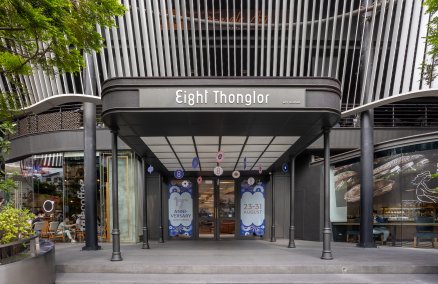I made my first sale at Lachetta in Milan after two terrible seasons. After that I went to a fair in Berlin, where my original T-shirt designs caught the eye of a buyer from Topshop. She gave me the opportunity to open my first concession store in Topshop’s flagship store on Oxford Street, London.
At London College of Fashion, I was practically given the brand name Lalalove. My classmates would always spell my last name wrong or pronounce it too quickly. They made Charoenlab sound like Cha-ren-la or even just La-la-la.
I lived in a house with like-minded people enrolled in design school. I was doing an unpaid internship, and worked as a stylists’ assistant at Dazed & Confused for free for several years. At the same time I was trying to finish up my thesis, maintain a social life and make enough money to get by in London.
I used to carry my T-shirts on the bus to sell at Portobello and Spitalfields Markets. I was rejected four times before I managed to reserve a space—it was a period of ups and downs.
I never originally intended to bring the brand to Thailand. I didn’t think Thai people would get my designs—it’s a love-it-or-you-hate-it style that can be difficult to pull off: unicorns, stars, sea creatures.
Style depends on the individual. It’s a mirror reflecting who you are to the world. Everyone has their own style. Thai people have become more and more individual, developing their own critical approach to style. The fashion scene here has never been better.
Thais have more than enough potential to compete with international designers. I’m not just talking about the fashion industry, but all creativity related jobs. The value of Thai design is so often overlooked— you won’t get the government’s attention unless you’re making OTOP products. Thai designers have been helping each other to put Thailand in the fashion spotlight.
I worry about newly-graduated fashion designers who think they can start their own brand right away. It’s not about the art of design but also marketing strategies and experience. I’ve talked to my interns about it. Thai university fails to create young blood with the right experience.
Every designer should learn the art of management. Don’t just spend money hiring someone to sew your dress; you need to get an apprenticeship at a design house to learn the skills for yourself. That’s how I spent my days in London, and I still rely on those skills.
What I like most about being a fashion stylist is seeing a simple, sorry-looking piece of cloth, and then using the lights, the setting and the models to turn it into something special. It takes time and diligence.
I learned how to select fine materials during my time as a sales assistant for Gucci, and how to design shop outlets from doing visual merchandising at Moschino.
Because we are a small brand, we can still experiment with new designs, predict and create trends. We don’t have to come up with new collections every season. In the future, after opening a few more outlets, we’ll have to be more responsible.
The most important thing in life is to always be positive. I am a mother, a fashion designer and still a daughter. This is what keeps me happy. It doesn’t matter how much money you earn if you’re stuck in a job you hate.
In the future, I want to open my own shop in England. I am getting there. I get the fuel to keep moving forward from seeing my collections on sale in Europe and receiving recognition. I know I have to work harder, but that’s something I have to deal with and find joy in the process of solving problems. Or just lose some weight.















